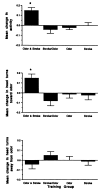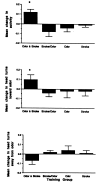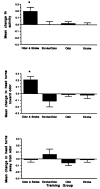Olfactory classical conditioning in neonates
- PMID: 2011429
- PMCID: PMC1952659
Olfactory classical conditioning in neonates
Abstract
One-day-old, awake infants underwent an olfactory classical conditioning procedure to assess associative learning within the olfactory system of newborns. Experimental infants received ten 30-second pairings of a novel olfactory conditioned stimulus (a citrus odor of neutral value) and tactile stimulation provided by stroking as the reinforcing unconditioned stimulus (a stimulus with positive properties). Control babies received only the odor, only the stroking, or the stroking followed by the odor presentation. The next day, all infants, in either the awake or sleep state, were given five 30-second presentations of the odor. Results were analyzed from video tapes scored by an observer unaware of the infants' training condition. The results indicate that only those infants who received the forward pairings of the odor and stroking exhibited conditioned responding (head turning toward the odor) to the citrus odor. The performance of the conditioned response was not affected by the state of the baby during testing, because both awake and sleeping infants exhibited conditioned responses. Furthermore, the expression of the conditioned response was odor specific; a novel floral odor presented during testing did not elicit conditioned responses in the experimental babies. These results suggest that complex associative olfactory learning is seen in newborns within the first 48 hours of life. These baseline findings may serve as normative data against which observation from neonates at risk for neurological sequelae may be compared.
Figures




Similar articles
-
Reinforcers in infancy: classical conditioning using stroking or intra-oral infusions of milk as UCS.Dev Psychobiol. 1988 Apr;21(3):215-23. doi: 10.1002/dev.420210303. Dev Psychobiol. 1988. PMID: 3371554
-
Norepinephrine and learning-induced plasticity in infant rat olfactory system.J Neurosci. 1989 Nov;9(11):3998-4006. doi: 10.1523/JNEUROSCI.09-11-03998.1989. J Neurosci. 1989. PMID: 2585063 Free PMC article.
-
Associative Processes in Early Olfactory Preference Acquisition: Neural and Behavioral Consequences.Psychobiology (Austin, Tex). 1989;17(1):29-33. doi: 10.3758/bf03337814. Psychobiology (Austin, Tex). 1989. PMID: 17572798 Free PMC article.
-
Sensing danger through the olfactory system: the role of the hypothalamic dorsal premammillary nucleus.Neurosci Biobehav Rev. 2008 Sep;32(7):1228-35. doi: 10.1016/j.neubiorev.2008.05.009. Epub 2008 May 13. Neurosci Biobehav Rev. 2008. PMID: 18550169 Review.
-
Olfactory sensory and perceptual evaluation in newborn infants: A systematic review.Dev Psychobiol. 2021 Nov;63(7):e22201. doi: 10.1002/dev.22201. Dev Psychobiol. 2021. PMID: 34674234
Cited by
-
Ecologically relevant neurobehavioral assessment of the development of threat learning.Learn Mem. 2016 Sep 15;23(10):556-66. doi: 10.1101/lm.042218.116. Print 2016 Oct. Learn Mem. 2016. PMID: 27634146 Free PMC article. Review.
-
Touch-induced face conditioning is mediated by genetic variation in opioid but not oxytocin receptors.Sci Rep. 2018 Jun 13;8(1):9004. doi: 10.1038/s41598-018-27199-2. Sci Rep. 2018. PMID: 29899398 Free PMC article.
-
Changes of olfactory abilities in relation to age: odor identification in more than 1400 people aged 4 to 80 years.Eur Arch Otorhinolaryngol. 2015 Aug;272(8):1937-44. doi: 10.1007/s00405-014-3263-4. Epub 2014 Sep 20. Eur Arch Otorhinolaryngol. 2015. PMID: 25238811 Free PMC article.
-
Bench to cribside: the path for developing a neuroprotectant.Transl Stroke Res. 2013 Apr;4(2):258-77. doi: 10.1007/s12975-012-0233-2. Epub 2012 Dec 21. Transl Stroke Res. 2013. PMID: 24323277 Review.
-
Children's hedonic responses to the odors of alcoholic beverages: a window to emotions.Alcohol. 2008 Jun;42(4):249-60. doi: 10.1016/j.alcohol.2008.03.129. Alcohol. 2008. PMID: 18539246 Free PMC article.
References
-
- Sullivan RM, Wilson DA, Wong R, Correa A, Leon M. Modified behavioral and olfactory bulb responses to maternal odors in preweanling rats. Dev Brain Res. 1990;53:243–247. - PubMed
-
- Hofer MA, Shair H, Singh P. Evidence that maternal ventral skin substances promote suckling in infant rats. Physiol Behav. 1976;17:131–136. - PubMed
-
- Leon M. Chemical communication in mother-young interactions. In: Vandenbergh JG, editor. Pheromones and Reproduction in Mammals. Academic Press; New York, NY: 1983. pp. 39–77.
-
- Johanson IB, Polefrone JM, Hall WG. Appetitive conditioning in neonatal rats: conditioned ingestive responding to stimuli paired with oral infusions of milk. Dev Psychobiol. 1984;17:357–381. - PubMed
-
- Sullivan RM, Brake SC, Hofer MA, et al. Huddling and independent feeding of neonatal rats is enhanced by a conditioned change in behavioral state. Dev Psychobiol. 1986;19:625–635. - PubMed
Publication types
MeSH terms
Grants and funding
LinkOut - more resources
Full Text Sources
Other Literature Sources
